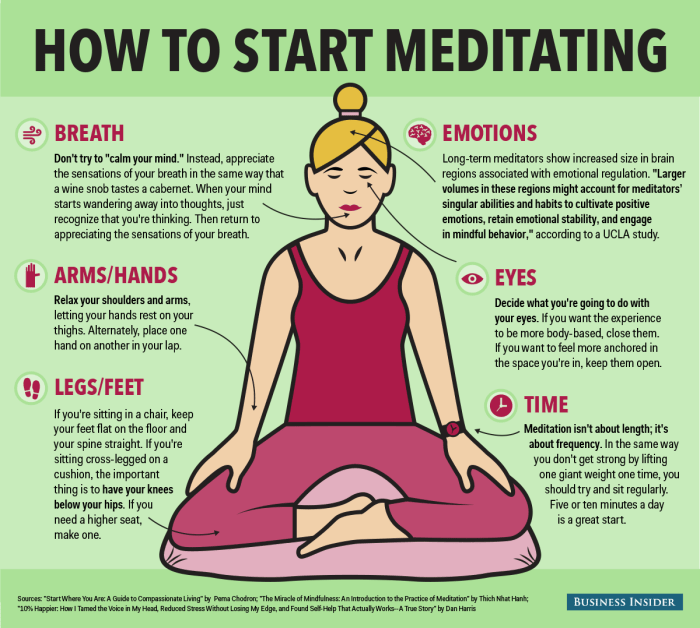Meditation for Beginners takes center stage as we dive into the world of mindfulness, exploring its benefits, techniques, and tips for establishing a regular practice. Get ready to embark on a journey towards inner peace and self-discovery!
Whether you’re new to meditation or looking to enhance your practice, this guide will provide you with the tools and knowledge needed to kickstart your meditation journey.
Understanding Meditation

Meditation is a practice that involves focusing the mind on a particular object, thought, or activity to achieve a state of mental clarity and inner peace.
Its purpose is to calm the mind, reduce stress, increase self-awareness, and promote emotional well-being.
Benefits of Meditation for Beginners
- Improves focus and concentration
- Reduces anxiety and stress
- Promotes relaxation and better sleep
- Enhances self-awareness and emotional intelligence
- Helps in managing emotions and reactions
Types of Meditation Practices Suitable for Beginners
- Mindfulness Meditation: Focuses on being present in the moment and observing thoughts without judgment.
- Guided Meditation: Involves following the instructions of a teacher or audio guide to lead you through the practice.
- Mantra Meditation: Involves repeating a word or phrase to focus the mind and achieve a state of calm.
- Yoga Meditation: Combines physical postures with breathwork and meditation to promote relaxation and mindfulness.
- Body Scan Meditation: Involves systematically focusing on different parts of the body to release tension and promote relaxation.
Getting Started with Meditation: Meditation For Beginners

To begin your meditation practice as a beginner, follow these steps to create a routine that works for you.
Step-by-Step Guide for Beginners
- Find a quiet and comfortable space where you can sit or lie down without distractions.
- Set a timer for your desired meditation session length, starting with just a few minutes to build your practice.
- Sit or lie down in a relaxed position, close your eyes, and focus on your breath or a mantra to center your mind.
- Allow thoughts to come and go without judgment, gently guiding your focus back to your breath or mantra when distractions arise.
- Gradually increase your meditation session length as you become more comfortable with the practice.
Creating a Conducive Environment, Meditation for Beginners
- Dim the lights or light a candle to create a calming atmosphere.
- Use cushions or a meditation pillow to support your posture and make sitting more comfortable.
- Play soft music or nature sounds to enhance relaxation and focus during your practice.
- Avoid meditating after heavy meals or when you are overly tired to maintain alertness and focus.
Overcoming Common Challenges
- Difficulty focusing: Practice mindfulness by bringing your attention back to your breath whenever you feel distracted.
- Restlessness: Experiment with different meditation techniques to find what works best for you, such as walking meditation or guided visualization.
- Impatience: Remember that progress takes time, and be patient with yourself as you develop your meditation practice.
- Inconsistency: Set a regular schedule for meditation practice, incorporating it into your daily routine to establish a habit.
Techniques for Beginners
Meditation offers a variety of techniques that can help beginners ease into the practice and experience its benefits. Let’s explore some popular techniques such as mindfulness, guided meditation, and body scan, along with examples of beginner-friendly exercises for each.
Mindfulness
Mindfulness meditation involves focusing on the present moment without judgment. It helps increase awareness, reduce stress, and improve mental clarity.
- Find a quiet place to sit comfortably.
- Close your eyes and focus on your breath, bringing your attention back whenever it wanders.
- Notice any sensations, thoughts, or emotions without getting attached to them.
Guided Meditation
Guided meditation uses a narrator or teacher to lead you through the practice, making it ideal for beginners who may find it challenging to meditate on their own.
- Listen to a guided meditation recording or app.
- Follow the instructions provided, focusing on your breath or a specific visualization.
- Allow yourself to relax and let go of any tension or stress.
Body Scan
Body scan meditation involves systematically focusing on different parts of the body to promote relaxation and awareness of physical sensations.
- Lie down or sit in a comfortable position.
- Start at your toes, gradually moving up through each body part, noticing any tension or discomfort.
- Relax each area as you scan through, releasing any tightness or stress.
Establishing a Routine
Creating a consistent routine for meditation is key to experiencing its full benefits. By setting aside time each day for your practice, you can cultivate a sense of mindfulness and inner peace.
Setting Realistic Goals
- Start small: Begin with just a few minutes of meditation each day and gradually increase the duration as you become more comfortable.
- Focus on consistency: Aim to meditate at the same time each day to build a habit and make it easier to stick to your routine.
- Acknowledge progress: Celebrate small victories along the way, whether it’s increased focus, reduced stress, or a greater sense of calm.
Integrating Meditation into Daily Life
- Morning routine: Kickstart your day with a meditation session to set a positive tone for the hours ahead.
- Lunch break meditation: Take a few minutes during your lunch break to reset and recharge with a quick meditation session.
- Evening wind-down: End your day with a calming meditation practice to help relax your mind and body before bedtime.
